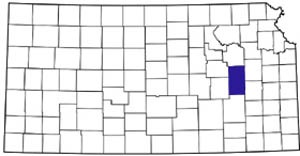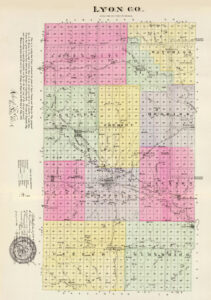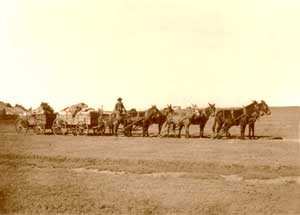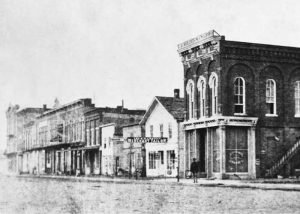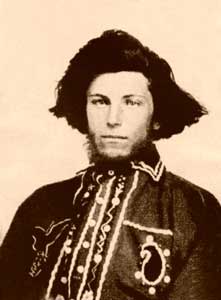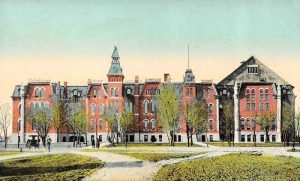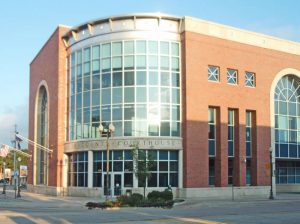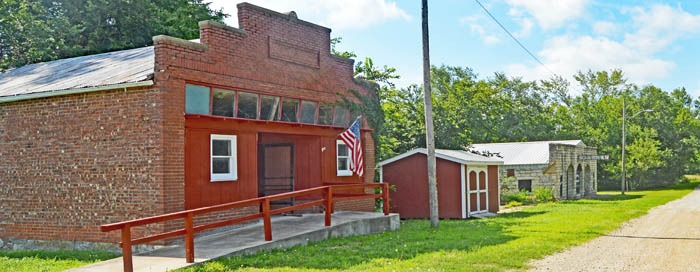Towns & Places:
Admire
Allen
Americus
Bushong – Ghost Town
Emporia – County Seat
Hartford
Miller
Neosho Rapids
Olpe
Reading
Situated in east-central Kansas, Lyon County was initially created as Breckenridge County by the first Kansas Territorial Legislature in 1855. It was named for John C. Breckenridge, who was elected Vice-President of the United States the following year. When first created, it was attached to Madison County for all civil and judicial purposes, and Columbia was designated as the county seat, but no county business was transacted. By February 17, 1857, the county was fully organized and detached from Madison County, with the temporary county seat located at Waterloo. In the fall of 1858, Americus was voted by the people to become the county seat.
One of the first settlers in the area, Charles H. Withington, settled in the extreme northern part of the county on the Santa Fe Trail, a short distance south of present-day Allen, Kansas, in 1846. In 1854, he opened a store, which was the first in the county and the only one in the region outside of Indian posts. His store also served as a hotel and supply station. Withington was influential in the settlement of the county and prominent in all public affairs. In April 1855, Oliver Phillips was located on 142 Mile Creek. In 1859, he was elected to the legislature, was a delegate to the Osawatomie Convention, and held several county offices. Others who came around the same time were Chris Ward, J. S. Pigman, Charles Johnson, James Pheanis, David Vangundy, John Rosenquist, Joseph Moon, Reverend Thomas J. Addis (at that time, the only free-state man), and many more, who, with very few exceptions, settled along the creeks in the northern half of the county.
One of the first settlements in the county was established in 1856, first called Florence, before changing to Neosho City, then Italia, and finally to Neosho Rapids. The following year, Emporia and Americus were laid out, and in 1858, the settlements of Hartford, Waterloo, Fremont, and Forest Hill.
As more new settlers continued to make their homes in the county, and by 1857, getting their mail became a large concern. Previous to this time, the mail for the area settlements had been thrown off the Santa Fe Trail wagons at Withington’s Store and was distributed by a horseman at private expense. When the government began delivering the mail by way of Westport, Missouri, and Council Grove to an established a post office at Columbia, this caused a great deal of dissatisfaction, as the settlers did not wish to trust the pro-slavery men who handled it.
Finally, they secured a box at Lawrence, where all mail was sent and then brought in by private conveyance to the hotel at Emporia. John Fowler, the postmaster at Columbia in the fall of 1857, resigned, and the office was moved to Emporia, where W. H. Fick became postmaster. In August, hack lines were established to Topeka and Lawrence. A great deal of the mail was lost, there being about three bushels of mail belonging to Emporia lying at Osawatomie in January 1858. The following year, regular mail routes were established from Council Grove to Fort Scott through Emporia and from Lawrence to Emporia.
At about the same time, freighters were active on the Burlingame Road, a government trail from Fort Leavenworth to Fort Sill Indian Territory. The trail headed southwest from Emporia to Wichita and beyond, with freighters hauling merchandise, lumber, foodstuffs, and most importantly – whiskey. Along the frontier trail, these men sometimes spied gruesome sights, including one occasion when they were greeted by a group of eight men hanging to an oak tree — allegedly horse thieves. Another was a settler, lying dead, killed by a freighter who had been angered when hit by a neck yoke.
The first newspaper was the Kanzas News (later the Emporia News), founded in 1857. The first sawmill was built by G. D. Humphreys on the Cottonwood River the same year, and the first school in the county was established in 1858.
In February 1860, the residents voted to move the county seat to Emporia, where it remains today. There were about 3,500 residents in the county at that time, but that year, the area suffered a severe drought, and many moved eastward. Some relief was provided to those who stayed, but the county would continue to suffer an economic downturn the following year when the Civil War broke out.
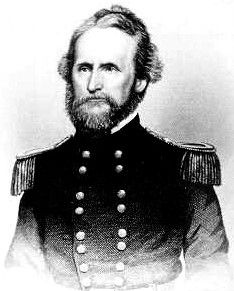
General Nathaniel Lyon
The first military company to leave for the war was the “Emporia Guards” in May 1861, numbering about 50 men. In August. A. J. Mitchell raised a company of artillery numbering 47 men, and later, L. T. Heritage recruited more soldiers, which became Company B of the Eighth Regiment.
With the Civil War in full gear, the county name was changed in February 1862, as the former Vice President Breckenridge had become a secessionist and a high-ranking officer in the Confederate Army. The patriotic anti-slavery legislature changed the county’s name to Lyon in honor of Nathaniel Lyon, the Union general who had lost his life in the Battle of Wilson’s Creek, Missouri, the previous August.
In the fall of 1862, in response to President Abraham Lincoln’s call for more troops, 150 Lyon County men immediately offered their services. They were recruited by Preston B. Plumb and formed a company in the Eleventh Regiment. Soon afterward, they were engaged in a battle at Prairie Grove, Arkansas, where several were killed.
Several tragedies occurred in connection with the guerrilla activities between pro-slavery and anti-slavery bands. One of these was the death of Mrs. Carver, who was killed by a free-state mob from Topeka. She was in bed, and when the men were refused admission to the house, they fired into the building at random, and two of the shots hit Mrs. Carver.
In 1862, the most noted raid occurred in the county’s history when Judge A. I. Baker branded the notorious “Bloody Bill” Anderson, his father, and brother Jim as horse thieves and later was obliged to shoot the elder Anderson in self-defense. A mob at Americus hung a Mexican who belonged to the Anderson gang at about the same time.
A few weeks later, the Andersons, with four others, one of whom represented himself to be William Quantrill, came to the Baker home, persuaded him to go to his store to get them some whiskey, and just as he was going down the cellar steps shot him several times. Baker shot back but only inflicted a flesh wound upon Jim Anderson.
The ruffians then shot Baker’s brother-in-law, Segur, and threw him into the cellar. With both men in the cellar, the bushwhackers piled boxes on the cellar door and set them on fire. Baker died before the fire reached him, and Segur escaped by a back window but died a few hours later. All of Baker’s property was destroyed by fire, and his horses were stolen. After several other robberies, the guerrillas came to the residence of C. H. Withington at Allen. They placed all the men under arrest, took what they wanted, and destroyed some property. Mr. Withington escaped death through the intercession of William Quantrill. At Elm Creek, they attacked the house of a Mr. Jacoby, whose life was saved by a Santa Fe Trail wagon train that happened to be passing.
In March 1863, the Kansas Legislature passed an act that established the Kansas State Normal School in Emporia. The school’s first graduating class consisted of two women in 1867 when the first permanent building was completed.
In 1864, when General Sterling Price threatened Kansas, 300 more answered the call to repel the invasion. They were on active duty for about a month.
The first efforts to secure a railroad were in 1864, but it was not until 1870 that the first railroad was built — the Atchison, Topeka & Santa Fe Railroad, which ran south from Topeka. The Missouri-Kansas-Texas Railroad was built in the same year, and more lines and branches would be added in subsequent years.
A stone courthouse was built on the northwest corner of Third Avenue and Commercial Street in Emporia in 1866 at almost $20,000.
As more settlers arrived in the county, more settlements, including Reading, were born in 1867. A decade later, Butlertown was founded in 1877, but two years later, it was moved just across the Topeka & Santa Fe Railroad tracks and renamed Olpe. The town of Hortonburg, which later was renamed Lang, was laid out in 1882, and four years later, in 1886, Allen, Bushong, and Admire were established along the Missouri Pacific Railroad in northern Lyon County.
By the turn of the century, Lyon County supported about 25,000 people, who primarily supported themselves by farming corn, oats, wheat, and other crops. The county also sported numerous fruit trees, primarily apples, and hundreds of people raised livestock.
The Lyon County Courthouse continued to be used until about 1903, when a new courthouse was erected on the northeast corner of Fourth Avenue and Commercial Street at about $55,000.
Over the next century, the county diversified into manufacturing, services, health care, and academic ventures, especially in Emporia, the county’s largest city.
In February 1923, the name of the Kansas State Normal School in Emporia was changed to the Kansas State Teachers College, leading the path for Emporia and the county into a world of academics. In July 1974, the name was changed to Emporia Kansas State College, and the name changed again on April 21, 1977, to Emporia State University. Since 1863, more than 150,000 students have studied at ESU and have gone on to careers in business and industry, education, the professional fields, and many other areas throughout the world.
In 2001, Lyon County got yet another new courthouse. The old structure was torn down, along with several other buildings, and a new 3-story building containing nearly 100,000 square feet was built.
Lyon County has consistently grown in population throughout the years and today is called home to about 36,000 people. Situated throughout the county are several historic sites, monuments, and museums that tell the story of Lyon County’s rich history and culture. The county is nestled in the Flint Hills region of eastern Kansas, about 100 miles southwest of Kansas City.
Contact Information:
Lyon County
430 Commercial St.
Emporia, Kansas 66801
620-342-4950
Compiled by Kathy Alexander/Legends of Kansas, updated October 2023.
Also See:
About the Article: Much of the historical text in this article comes from Kansas: A Cyclopedia of State History, edited by Frank W. Blackmar, published in 1912, and Kansas: History of the State of Kansas, by William G. Cutler, published in 1883. However, other sources have also been used, the content combined and heavily edited.


